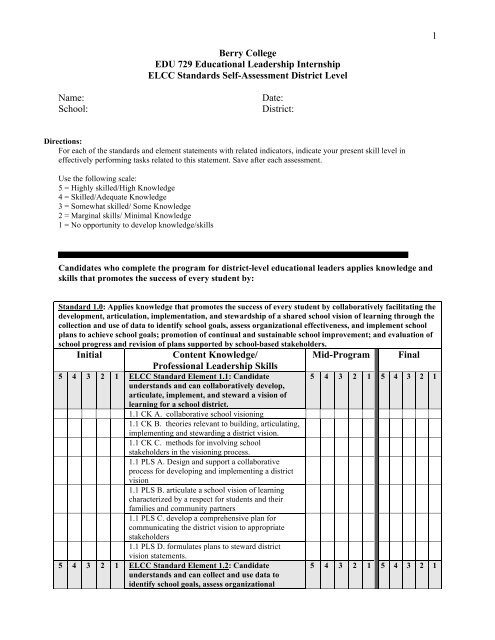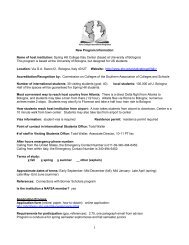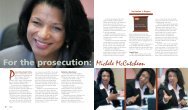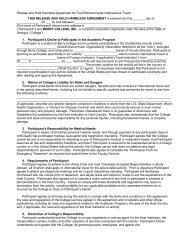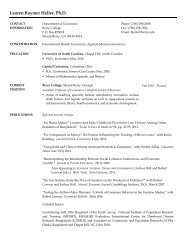ELCC Standards Self-Assessment District Level - Berry College
ELCC Standards Self-Assessment District Level - Berry College
ELCC Standards Self-Assessment District Level - Berry College
You also want an ePaper? Increase the reach of your titles
YUMPU automatically turns print PDFs into web optimized ePapers that Google loves.
<strong>Berry</strong> <strong>College</strong>EDU 729 Educational Leadership Internship<strong>ELCC</strong> <strong>Standards</strong> <strong>Self</strong>-<strong>Assessment</strong> <strong>District</strong> <strong>Level</strong>1Name:School:Date:<strong>District</strong>:Directions:For each of the standards and element statements with related indicators, indicate your present skill level ineffectively performing tasks related to this statement. Save after each assessment.Use the following scale:5 = Highly skilled/High Knowledge4 = Skilled/Adequate Knowledge3 = Somewhat skilled/ Some Knowledge2 = Marginal skills/ Minimal Knowledge1 = No opportunity to develop knowledge/skillsCandidates who complete the program for district-level educational leaders applies knowledge andskills that promotes the success of every student by:Standard 1.0: Applies knowledge that promotes the success of every student by collaboratively facilitating thedevelopment, articulation, implementation, and stewardship of a shared school vision of learning through thecollection and use of data to identify school goals, assess organizational effectiveness, and implement schoolplans to achieve school goals; promotion of continual and sustainable school improvement; and evaluation ofschool progress and revision of plans supported by school-based stakeholders.InitialContent Knowledge/Professional Leadership Skills5 4 3 2 1 <strong>ELCC</strong> Standard Element 1.1: Candidateunderstands and can collaboratively develop,articulate, implement, and steward a vision oflearning for a school district.1.1 CK A. collaborative school visioning1.1 CK B. theories relevant to building, articulating,implementing and stewarding a district vision.1.1 CK C. methods for involving schoolstakeholders in the visioning process.1.1 PLS A. Design and support a collaborativeprocess for developing and implementing a districtvision1.1 PLS B. articulate a school vision of learningcharacterized by a respect for students and theirfamilies and community partners1.1 PLS C. develop a comprehensive plan forcommunicating the district vision to appropriatestakeholders1.1 PLS D. formulates plans to steward districtvision statements.5 4 3 2 1 <strong>ELCC</strong> Standard Element 1.2: Candidateunderstands and can collect and use data toidentify school goals, assess organizationalMid-ProgramFinal5 4 3 2 1 5 4 3 2 15 4 3 2 1 5 4 3 2 1
2effectiveness, and implement district plans toachieve district goals1.2 CK A. the purposes and processes for collecting,analyzing, and using appropriate district data to drivedecision making that effects student learning;1.2 CK B. designing and using assessment data forlearning;1.2 CK C. organizational effectiveness and learningstrategies;1.2 CK D. organizational effectiveness and learningstrategies;1.2 CK E. implementation and evaluation ofdistrict improvement processes;1.2 CK F. variables that affect studentachievement.1.2 PLS A. develop and use evidence-centeredresearch strategies and strategic planning processes,1.2 PLS B. create district-based strategic and tacticalgoals,1.2 PLS C. collaboratively develop implementationplans to achieve those goals;1.2 PLS D. evaluate district improvement processes.5 4 3 2 1 <strong>ELCC</strong> <strong>Standards</strong> Element 1.3: Candidateunderstands and can promote continual andsustainable district improvement.1.3 CK A. continual and sustained improvementmodels and processes,1.3 CK B. strategic district management of humancapital and its effect on continual and sustainableimprovement,1.3 CK C. district change processes for continual andsustainable improvement.1.3 PLS A. identifies strategies or practices to buildorganizational capacity to promote continual andsustainable district improvement,1.3 PLS B. identify strategies for developing districtleadership capacity;1.3 PLS. C. create a district plan to implementtransformational change;1.3 PLS D. design a comprehensive, district-levelprofessional development plan.5 4 3 2 1 <strong>ELCC</strong> Standard Element 1.4: Candidateunderstands and can evaluate district progressand revise district plans by school stakeholders.1.4. CK A. effective strategies for monitoring theimplementation, revision of plans to achieve districtimprovement goals, and program evaluation models.1.4. PLS A. develop a district plan to monitorprogram development and implementation of districtgoals,1.4. PLS B. construct an evaluation process to assessthe effectiveness of district plans and programs,1.5 PLS C. interprets information and communicatesprogress toward achievement of district vision and5 4 3 2 1 5 4 3 2 15 4 3 2 1 5 4 3 2 1
3goals for educators in the community and otherstakeholders.<strong>ELCC</strong> Standard 2.0: sustaining a district culture conducive to collaboration, trust, and a personalizedlearning environment with high expectations for students; creating and evaluating a comprehensive, rigorous,and coherent curricular and instructional district program; developing and supervising the instructional andleadership capacity across the district; and promoting the most effective and appropriate technologies tosupport teaching and learning within the district.InitialContent Knowledge/Professional Leadership Skills5 4 3 2 1 <strong>ELCC</strong> Standard Element 2.1: Candidatesunderstand and can sustain a district culture andinstructional program conducive to student learningthrough collaboration, trust, and a personalizedlearning environment with high expectations forstudents.2.1 CK A. theories on human development behavior,personalized learning environment, and motivation;2.1 CK B. district culture and ways it can beinfluenced to ensure student success.2.1 PLS A. lead district change and collaboration thatfocuses on improvements to district practices, studentoutcomes, curriculum, and instruction;2.1 PLS B. incorporate cultural competence indevelopment of programs, curriculum, andinstructional practices;2.1 PLS C. use learning management systems tosupport persona use learning management systems tosupport personalized learning across the district;2.1 PLS D. develop comprehensive programs thatmeet the unique learning needs and interests ofdiverse student populations and school personnelacross the district;2.1 PLS E. promote trust, equity, fairness, andrespect among school board members, faculty,parents, students, and the district community.5 4 3 2 1 <strong>ELCC</strong> Standard Element 2.2: Candidates understandand can create and evaluate a comprehensive,rigorous, and coherent curricular and instructionaldistrict program.2.2. CK A. curriculum development and instructionaldelivery theories;2.2.CK B. measures of teacher performance;2.2.CK C. multiple methods of program evaluation,accountability systems, data collection, and analysisof evidence;2.2 CK D. district technology and informationsystems to support and monitor student learning.2.2 PLS A. align curriculum and instruction withdistrict assessments;2.2 PLS. B. collaborate with faculty across thedistrict to plan, implement, and evaluatea coordinated, aligned, and articulatedcurriculum;Mid-ProgramFinal5 4 3 2 1 5 4 3 2 15 4 3 2 1 5 4 3 2 1
42.2 PLS C. use evidence-centered research inmaking curricular and instructional decisions;2.2 PLS D. provide district resources to supportquality curriculum and instruction;2.2 PLS E. design district evaluation systems andmake district plans based on multiple measures ofteacher performance and student outcomes, andprovide feedback based on evidence.5 4 3 2 1 <strong>ELCC</strong> Standard Element 2.3: Candidatesunderstand and can develop and supervise theinstructional and leadership capacity across thedistrict.2.3 CK A. high-quality professional developmentfor school staff and leaders;2.3 CK B. instructional leadership practices;2.3 CK C. leadership theory, change processes, andevaluation;2.3 CK D. district systems that promote effective andefficient practices in the management of people,processes, and resources.2.3 PLS A. collaboratively develop plans thedistrict’s effects on teaching and learning;2.3 PLS B. design the use of differentiatedinstructional strategies, curriculum materials, andtechnologies to maximize high-quality instructionwithin the district;2.3 PLS C. facilitate school leadership throughdevelopment of district activities that focus onteaching and student learning;2.3 PLS D. design professional growth plans toincrease the capacity of school staff and leaders thatreflect national professional development standards;2.3 PLS E. use a variety of district approaches toimprove school staff performance;2.3 PLS F. develop district systems for effective andefficient management of policies, procedures, andpractices.5 4 3 2 1 <strong>ELCC</strong> Standard Element 2.4: Candidatesunderstand and can promote the most effective andappropriate technologies to support teaching andlearning within the district.2.4.CK A. technology and its uses for instructionwithin the district;2.4.CK B. infrastructures for the ongoing support,review, and planning of district instructionaltechnology.2.4.PLS A. use technologies to enrich districtcurriculum and instruction;2.4 PLS B. monitor instructional practices withinthe district and provide assistance to schooladministrators;2.4 PLS C. use district technology and performancemanagement systems to monitor, analyze, andevaluate district data results for accountabilityreporting.5 4 3 2 1 5 4 3 2 15 4 3 2 1 5 4 3 2 1
5<strong>ELCC</strong> Standard 3.0: ensuring the management of the district’s organization, operation, and resourcesthrough monitoring and evaluating district management and operational systems; efficiently using human,fiscal, and technological resources within the district; promoting district-level policies and procedures thatprotect the welfare and safety of students and staff across the district; developing district capacity fordistributed leadership; and ensuring that district time focuses on high-quality instruction and studentlearning.InitialContent Knowledge/ ProfessionalLearning Skills5 4 3 2 1 <strong>ELCC</strong> Standard Element 3.1: Candidatesunderstand and can monitor and evaluate districtmanagement and operational systems.3.1 CK A. district management of organizational,operational, and legal resources;3.1 CK B. district management of marketing andpublic relations functions.3.1.PLS A. analyze district processes and operationsto identify and prioritize strategic and tacticalchallenges for the district;3.1 PLS B. develop district operational policies andprocedures;3.1 PLS C. develops plans to implement and managelong-range goals for the district.5 4 3 2 1 <strong>ELCC</strong> Standard Element 3.2: Candidatesunderstand and can efficiently use human, fiscal, andtechnological resources within the district.3.2 CK A. methods and procedures for managingschool resources, including the strategic managementof human capital, district operations, and facilities;3.2 CK B. alignment of resources to district prioritiesand forecasting resource requirements for the district;3.2 CK C. technology and management systems.3.2 PLS A. develop multi-year fiscal plans andannual budgets aligned to the district’s priorities andgoals;3.2 PLS B. analyze a district’s budget and financialstatus;3.2 PLS C. develop facility and space utilizationplans for the district;3.2 PLS D. project long-term resource needs of adistrict;3.2 PLS E. use technology to manage district’soperational systems.5 4 3 2 1 <strong>ELCC</strong> Standard Element 3.3: Candidatesunderstand and can promote district-level policiesand procedures that protect the welfare and safety ofstudents and staff across the district.3.3 CK A. district strategies supporting safe andsecure learning environments including prevention,crisis management, and public relations;3.3 CK B. district strategies supporting studentdevelopment of self-management, civic literacy, andpositive leadership skills;3.3 CK C. district-based discipline managementpolicies and plans.Mid-ProgramFinal5 4 3 2 1 5 4 3 2 15 4 3 2 1 5 4 3 2 15 4 3 2 1 5 4 3 2 1
63.3 PLS A. improve and implement district policiesand procedures for safe and secure central office andschool-work environments (including district office,school personnel, students, and visitors) thatencompass crisis planning and management;3.3 PLS B. evaluate and implement district-widediscipline management plans.5 4 3 2 1 <strong>ELCC</strong> Standard Element 3.4: Candidatesunderstand and can develop district capacity fordistributed leadership.3.4 CK A. the meaning of distributed leadershipin a district environment and how to create andsustain it.3.4 PLS A. identify leadership capabilities of staff atvarious levels within the district;3.4 PLS B. model distributed leadership skills;3.4 PLS C. involve district and school personnel indecision making processes.5 4 3 2 1 <strong>ELCC</strong> Standard Element 3.5: Candidatesunderstand and can ensure that district time focuseson supporting high-quality school instruction andstudent learning.3.5 CK A. supervision strategies that ensure thatteachers across the district maximize time spent onhigh- quality instruction and student learning;3.5 CK B. management theories on effective districttime, priorities, and schedules.3.5 PLS A. develop district policies that protectinstructional time and schedules;3.5 PLS B. develop district calendars and schedules.5 4 3 2 1 5 4 3 2 15 4 3 2 1 5 4 3 2 1<strong>ELCC</strong> Standard 4.0: collaborating with faculty and community members, responding to diverse communityinterests and needs, and mobilizing community resources for the district by collecting and analyzinginformation pertinent to improvement of the district’s educational environment; promoting anunderstanding, appreciation, and use of the community’s diverse cultural, social, and intellectual resourcesthroughout the district; building and sustaining positive district relationships with families and caregivers;and cultivating productive district relationships with community partners.InitialContent Knowledge/Professional LearningSkills5 4 3 2 1 <strong>ELCC</strong> Standard Element 4.1: Candidates understandand can collaborate with faculty and communitymembers by collecting and analyzing informationpertinent to the improvement of the district’seducational environment4.1 CK A. collaboration and communicationtechniques to improve the district’s educationalenvironment;4.1 CK B. information pertinent to the district’seducational environment.4.1 PLS A. use collaboration strategies to collect,analyze, and interpret information pertinent to thedistrict environment;4.1 PLS B. communicates information about the districtenvironment to the community.Mid-ProgramFinal5 4 3 2 1 5 4 3 2 1
75 4 3 2 1 <strong>ELCC</strong> Standard Element 4.2: Candidates understandand can mobilize community resources by promotingan understanding, appreciation, and use of the diversecultural, social, and intellectual resources throughoutthe district.4.2 CK A. district cultural competence;4.2 CK B. diverse cultural, social and intellectualresources within a district community.4.2. PLS A. identify and use diverse communityresources to improve district programs.5 4 3 2 1 <strong>ELCC</strong> Standard Element 4.3: Candidates understandand can respond to community interests and needs bybuilding and sustaining positive district relationshipswith families and caregivers.4.3 CK A. the needs of students, parents or caregivers;4.3 CK B. district organizational culture thatpromotes open communication with families andcaregivers;4.3 CK C. district strategies for effective oral andwritten communication with families and caregivers;4.3 CK D. district collaboration methods forproductive relationships with families and caregivers.4.3 PLS A. conduct needs assessments of families andcaregivers within the district;4.3 PLS B. develop collaboration strategies foreffective district relationships with families andcaregivers;4.3 PLS C. involve families and caregivers in districtdecision making about their student’s education.5 4 3 2 1 <strong>ELCC</strong> Standard Element 4.4: Candidates understandand can respond to community interests and needs bybuilding and sustaining productive district relationshipswith community partners.4.4 CK A. the needs of district community partners;4.4 CK B. district organizational culture that promotesopen communication with community partners;4.4 CK C. district strategies for effective oral andwritten communication with community partners;4.4 CK D. district collaboration methods for productiverelationships with community partners.4.4 PLS A. conduct needs assessment of communitypartners;4.4 PLS B. develop effective relationships with avariety of district community partners;4.4 PLS C. involve community partners in thedecision-making processes within the district.5 4 3 2 1 5 4 3 2 15 4 3 2 1 5 4 3 2 15 4 3 2 1 5 4 3 2 1<strong>ELCC</strong> Standard 5.0: acting with integrity, fairness, and in an ethical manner to ensure a district system ofaccountability for every student’s academic and social success by modeling district principles of selfawareness,reflective practice, transparency, and ethical behavior as related to their roles within the district;safeguarding the values of democracy, equity, and diversity within the district; evaluating the potential moraland legal consequences of decision making in the district; and promoting social justice within the district toensure individual student needs inform all aspects of schooling.Initial Content Knowledge/Professional Mid-Program Final
8Learning Skills5 4 3 2 1 <strong>ELCC</strong> Standard Element 5.1: Candidatesunderstand and can act with integrity and fairness toensure a district system of accountability for everystudent’s academic and social success.5.1 CK A. practices demonstrating principles ofintegrity and fairness;5.1 CK B. federal, state, and local legal and policyguidelines that creates operational definitions ofaccountability, equity, and social justice within thedistrict.5.1 PLS A. act with integrity and fairness insupporting district policies and staff practices thatensure every students’ academic and social success;5.1 PLS B. create an infrastructure that helps tomonitor and ensure equitable district practices.5 4 3 2 1 <strong>ELCC</strong> Standard Element 5.2: Candidatesunderstand and can model principles of selfawareness, reflective practice, transparency, andethical behavior as related to their roles within thedistrict.5.2 CK A. the basic principles of ethical behaviorestablished by legal and professional organizations;5.2 CK B. the relationship between ethical behavior,district culture, and student achievement;5.2 CK C. the effect of ethical behavior on one’s ownleadership.5.2 PLS A. formulate a district-level leadershipgrounded in ethical standards and practices;5.2 PLS B. analyze district leadership decisions interms of established ethical practices.5 4 3 2 1 <strong>ELCC</strong> Standard Element 5.3: Candidatesunderstand and can safeguard the values ofdemocracy, equity, and diversity.5.3 CK A. democratic values, equity, and diversity.5.3 PLS A. develop, implement, and evaluate schoolpolicies and procedures that support democraticvalues, equity, and diversity issues;5.3 PLS B. develop appropriate communication skillsto advocate for democracy, equity, and diversity.5 4 3 2 1 <strong>ELCC</strong> Standard Element 5.4: Candidatesunderstand and can evaluate the potential moral andlegal consequences of decision making in a district.5.4 CK A. moral and legal consequences of decisionmaking in districts;5.4 CK B. strategies to prevent difficulties related tomoral and legal issues.5.4 PLS A. formulate sound district strategies toeducational dilemmas;5.4 PLS B. evaluate district strategies to preventdifficulties related to moral and legal issues.5 4 3 2 1 <strong>ELCC</strong> Standard Element 5.5: Candidatesunderstand and can promote social justice within thedistrict to ensure that individual student needs informall aspects of schooling.5.5 CK A. the relationship between social justice,5 4 3 2 1 5 4 3 2 15 4 3 2 1 5 4 3 2 15 4 3 2 1 5 4 3 2 15 4 3 2 1 5 4 3 2 15 4 3 2 1 5 4 3 2 1
9school culture, and student achievement;5.5 CK B. theories of efficacy.5.5 PLS A. review and critique district policies,programs, and practices to ensure that student needsinform all aspects of schooling, including socialjustice, equity, confidentiality, acceptance, andrespect between and among students and facultywithin the district;5.5 PLS B. develop the resiliency to uphold corevalues and persist in the face of adversity.<strong>ELCC</strong> Standard 6.0: understanding, responding to, and influencing the larger political, social, economic,legal, and cultural context within the district through advocating for district students, families, and caregivers;acting to influence local, district, state, and national decisions affecting student learning; and anticipating andassessing emerging trends and initiatives in order to adapt district-level leadership strategies.InitialContent Knowledge/ Professionallearning Skills5 4 3 2 1 <strong>ELCC</strong> Standard Element 6.1: Candidatesunderstand and can advocate for district students,families, and caregivers.6.1 CK A. policies, laws, and regulations enacted bystate, local, and federal authorities that affectdistricts;6.1 CK B. the effect that poverty, disadvantages,and resources have on families, caregivers,communities, students, and learning.6.1 PLS A. analyze how district law and policy isapplied consistently, fairly and ethically within theschool;6.1 PLS B. advocate based on an analysis of thecomplex causes of poverty and other disadvantages;6.1 PLS C. serve as a respectful spokesperson forstudents and families served by the district.5 4 3 2 1 <strong>ELCC</strong> Standard Element 6.2: Candidatesunderstand and can act to influence local, district,state, and national decisions affecting studentlearning in a district environment.6.2 CK A. the larger political, social, economic,legal, and cultural context;6.2 CK B. ways that power and political skills caninfluence local, state, or federal decisions.6.2 PLS A. advocate for district policies andprograms that promote equitable learningopportunities and student success;6.2 PLS B. communicate policies, laws, regulations,and procedures to appropriate district stakeholders.5 4 3 2 1 <strong>ELCC</strong> Standard Element 6.3: Candidatesunderstand and can anticipate and assess emergingtrends and initiatives in order to adapt district-levelleadership strategies.6.3 CK A. future issues and trends that can affectdistricts (e.g., entrepreneurial approaches);6.3 CK B. contemporary and emerging districtleadership strategies to address trends.6.3 PLS A. identify and anticipate emerging trendsMid-ProgramFinal5 4 3 2 1 5 4 3 2 15 4 3 2 15 4 3 2 1
10and issues likely to affect the district;6.3 PLS B. adapt district leadership strategies andpractice to address emerging district issues.Internship/Residency: (Mid-Program)Collaboratively planned experiences for future content knowledge and professional leadership skill development:Strengths identified:


